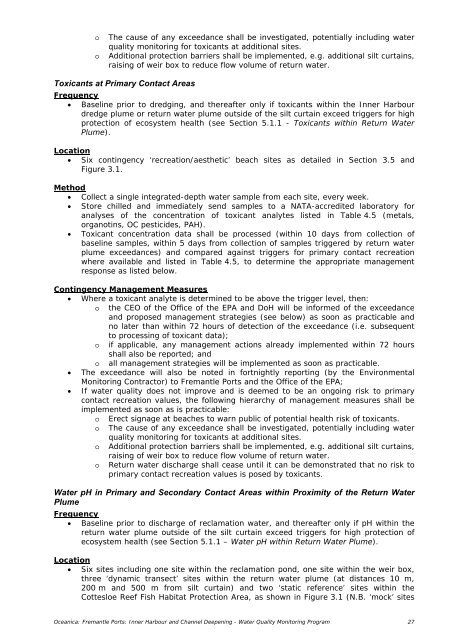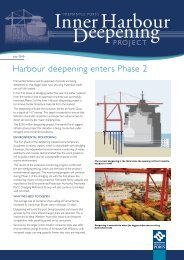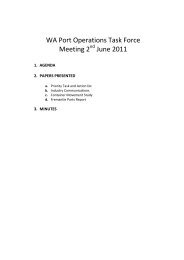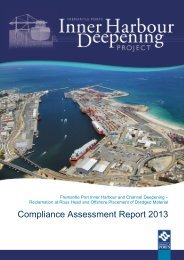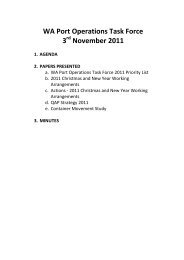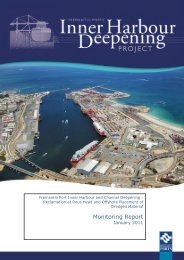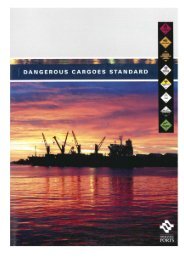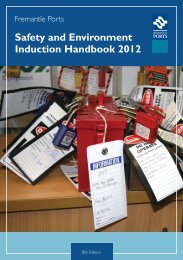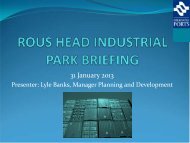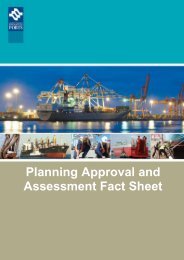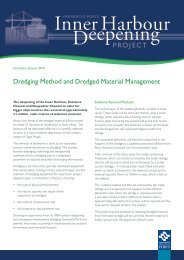Fremantle Port Inner Harbour and Channel ... - Fremantle Ports
Fremantle Port Inner Harbour and Channel ... - Fremantle Ports
Fremantle Port Inner Harbour and Channel ... - Fremantle Ports
You also want an ePaper? Increase the reach of your titles
YUMPU automatically turns print PDFs into web optimized ePapers that Google loves.
o<br />
o<br />
The cause of any exceedance shall be investigated, potentially including water<br />
quality monitoring for toxicants at additional sites.<br />
Additional protection barriers shall be implemented, e.g. additional silt curtains,<br />
raising of weir box to reduce flow volume of return water.<br />
Toxicants at Primary Contact Areas<br />
Frequency<br />
• Baseline prior to dredging, <strong>and</strong> thereafter only if toxicants within the <strong>Inner</strong> <strong>Harbour</strong><br />
dredge plume or return water plume outside of the silt curtain exceed triggers for high<br />
protection of ecosystem health (see Section 5.1.1 - Toxicants within Return Water<br />
Plume).<br />
Location<br />
• Six contingency ‘recreation/aesthetic’ beach sites as detailed in Section 3.5 <strong>and</strong><br />
Figure 3.1.<br />
Method<br />
• Collect a single integrated-depth water sample from each site, every week.<br />
• Store chilled <strong>and</strong> immediately send samples to a NATA-accredited laboratory for<br />
analyses of the concentration of toxicant analytes listed in Table 4.5 (metals,<br />
organotins, OC pesticides, PAH).<br />
• Toxicant concentration data shall be processed (within 10 days from collection of<br />
baseline samples, within 5 days from collection of samples triggered by return water<br />
plume exceedances) <strong>and</strong> compared against triggers for primary contact recreation<br />
where available <strong>and</strong> listed in Table 4.5, to determine the appropriate management<br />
response as listed below.<br />
Contingency Management Measures<br />
• Where a toxicant analyte is determined to be above the trigger level, then:<br />
o the CEO of the Office of the EPA <strong>and</strong> DoH will be informed of the exceedance<br />
<strong>and</strong> proposed management strategies (see below) as soon as practicable <strong>and</strong><br />
no later than within 72 hours of detection of the exceedance (i.e. subsequent<br />
to processing of toxicant data);<br />
o if applicable, any management actions already implemented within 72 hours<br />
shall also be reported; <strong>and</strong><br />
o all management strategies will be implemented as soon as practicable.<br />
• The exceedance will also be noted in fortnightly reporting (by the Environmental<br />
Monitoring Contractor) to <strong>Fremantle</strong> <strong>Port</strong>s <strong>and</strong> the Office of the EPA;<br />
• If water quality does not improve <strong>and</strong> is deemed to be an ongoing risk to primary<br />
contact recreation values, the following hierarchy of management measures shall be<br />
implemented as soon as is practicable:<br />
o Erect signage at beaches to warn public of potential health risk of toxicants.<br />
o The cause of any exceedance shall be investigated, potentially including water<br />
quality monitoring for toxicants at additional sites.<br />
o Additional protection barriers shall be implemented, e.g. additional silt curtains,<br />
raising of weir box to reduce flow volume of return water.<br />
o Return water discharge shall cease until it can be demonstrated that no risk to<br />
primary contact recreation values is posed by toxicants.<br />
Water pH in Primary <strong>and</strong> Secondary Contact Areas within Proximity of the Return Water<br />
Plume<br />
Frequency<br />
• Baseline prior to discharge of reclamation water, <strong>and</strong> thereafter only if pH within the<br />
return water plume outside of the silt curtain exceed triggers for high protection of<br />
ecosystem health (see Section 5.1.1 – Water pH within Return Water Plume).<br />
Location<br />
• Six sites including one site within the reclamation pond, one site within the weir box,<br />
three ‘dynamic transect’ sites within the return water plume (at distances 10 m,<br />
200 m <strong>and</strong> 500 m from silt curtain) <strong>and</strong> two ‘static reference’ sites within the<br />
Cottesloe Reef Fish Habitat Protection Area, as shown in Figure 3.1 (N.B. ‘mock’ sites<br />
Oceanica: <strong>Fremantle</strong> <strong>Port</strong>s: <strong>Inner</strong> <strong>Harbour</strong> <strong>and</strong> <strong>Channel</strong> Deepening - Water Quality Monitoring Program 27


